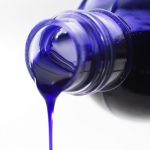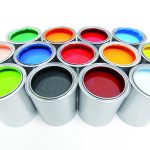Pigments & Inks
Whether in paints, varnishes, crayons or even cosmetics, colored pigments are used in numerous industries. Usually, insoluble, organic or inorganic pigments are dispersed in a liquid medium, processed or mixed with other powders for dry applications. Industrially, white pigments play a very important role: for the paper industry, calcium carbonate in particular should be mentioned here, of which around 3 million tons are processed annually in this sector alone. The demand for titanium dioxide is even greater, particularly in the building and coatings sector, where it is used in a volume of around 5-6 million tons per year.
Regardless of the area of application and the type of processing: The final optical properties of a color pigment depend in particular on the particle morphology (size distribution, particle shape) and – in the case of liquid processing – on the dispersion properties of the pigment suspension. 3P Instruments offers you a range of very helpful analysis methods for checking and optimizing these parameters.
Particle size and shape of pigment particles
While the basic color of a color coating is determined by the type of pigment, the grain size in particular, but also the shape of the individual pigment particles in general, has a major influence on the overall optical properties and also on the further processing of the color carriers. Particularly in the case of inorganic pigments, the particle size is controlled by grinding a corresponding starting material (often a mineral). In so-called dispersion paints, their color intensity and opacity depend primarily on the size of the pigment particles: the smaller the particles, the higher the opacity. In addition, particles that are too large can lead to visible unevenness, e.g. on a painted wall.
In applications such as paint spray cans or inkjet printers, the particle size is also a decisive quality factor, as oversized particles can lead to clogging of the nozzles, making the product unusable. In the case of nanoparticulate pigments, however, the size also has a direct influence on the color. The reason for this is the so-called plasmon resonance of light on nanoparticles. Here, the color can be directly controlled by the size of the nanoparticles. A well-known example is nanocolloidal gold, which was historically used to color glasses and can produce different shades of color between red and violet depending on the particle size. Precise control of the particle size is essential here.
In automotive applications, not only the particle size but also the particle shape is key for so-called effect pigments: metal effect coatings are characterized by the fact that they reflect the light depending on the incidence of light and create a metallic sheen. This is made possible by the platelet-like morphology of the pigment particles, which are oriented in parallel in the color coating. Exactly these morphological properties can be analyzed precisely and quickly with our Bettersizer devices, especially the Bettersizer S3– and Bettersizer 2600-series, using the unique combination of laser diffraction and dynamic image analysis. For the particle size of nanopigments, either our DT series acoustic spectrometers or the BeNano series DLS systems are suitable, depending on whether high-density inorganic particles or soft organic pigments are involved.
Investigation of pigment suspensions: Zeta potential, electrical conductivity, stability
Pigments must be brought into a stable dispersion for paints and inks. The stability of a pigment suspension is not only influenced by the size of the particles, but also by the properties of the medium, especially the viscosity, electrical conductivity and the charge interaction of the medium with the pigments. Here, the zeta potential can be used as a simple parameter to evaluate the charge ratios at the interface between particles and medium. Depending on the system, this parameter can be used directly as a stability parameter and indirectly provides information on the rheological properties as well as the coating behavior of the suspension in question. It is also ideal for the qualitative and quantitative optimization of the system with an additive or a binder solution. Depending on the application, 3P offers two measurement methods for determining the zeta potential: electrophoretic light scattering (ELS) implemented in our BeNano series devices and electroacoustics, used in the DT spectrometer series.
The essential pigment suspension properties such as stability, wetting and adhesion as well as layer formation are linked to electrical conductivity. 3P Instruments offers the possibility to characterize non-polar, organic systems with the DT-700 with regard to this parameter.
 Deutsch
Deutsch English
English



